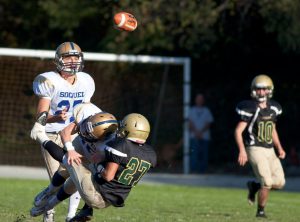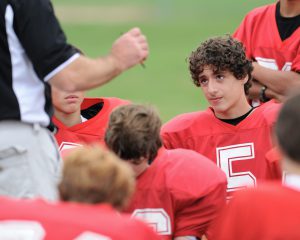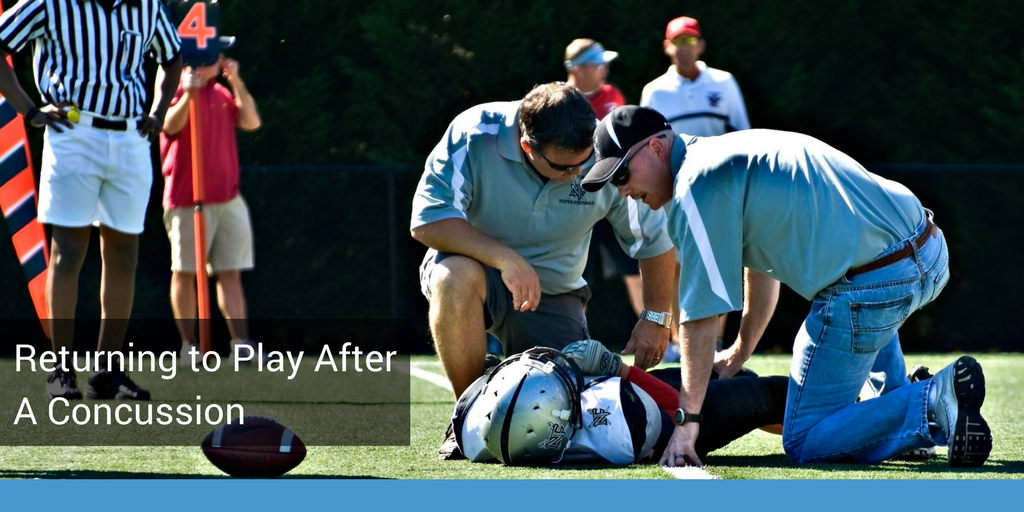DEFINITION: A concussion is a type of traumatic brain injury (TBI) caused by a bump, blow, or jolt to the head or by a hit to the body that causes the head and brain to move rapidly back and forth.
[Source: CDC]
Concussions in any athlete can have serious and long-term health effects, but the effects on youth can be especially damaging. While most kids don’t take part in contact sports until they are a little older, injuries, including concussions, can still happen in team sports.
Luckily, managing concussions properly from the moment they happen, right through to when an athlete returns to play, can help improve recovery. Keep reading to see how you can best manage a concussion.
FACT: In 2012, more than 160,000 children visited emergency rooms with sports-related concussions – that’s one every 3 minutes!
[SOURCE: SafeKids Infographic]
The Importance of Baseline & Impact Testing
Baseline Concussion Testing is done before the start of a sport season when an athlete has not yet been exposed to training or competition. These computerized tests measure Reaction Time, Memory Capacity, Speed of Mental Processing, and Executive Functioning of the brain, and take anywhere from 30 – 45 minutes to administer.
During the sport season, if a concussion occurs, the affected athlete takes the same test (a “post-injury”) again and the results are compared against the baseline. This is an extremely important part of concussion management because of how unique each concussion is. By using baseline testing, an individual’s post-injury test scores are compared against their own, personal results, rather than against the general population, which is much less specific. This allows medical professionals to treat the athlete with their results and symptoms in mind, and help them recover properly according to their needs [Source: Sports Concussion Institute].
Know the Signs of a Concussion
 In the event of a concussion, a player should be removed from the game immediately and not allowed to return. The signs and symptoms of a concussion can show from the moment the injury occurred, as well as hours or even days later. It’s important to monitor your injured athlete closely at all times, and seek medical attention right away. Only a physician will be able to truly diagnose a concussion.
In the event of a concussion, a player should be removed from the game immediately and not allowed to return. The signs and symptoms of a concussion can show from the moment the injury occurred, as well as hours or even days later. It’s important to monitor your injured athlete closely at all times, and seek medical attention right away. Only a physician will be able to truly diagnose a concussion.
Common symptoms of concussions include [Source: Stop Concussions]:
- Headaches
- Dizziness
- Neck pain
- Nausea/vomiting
- Loss of balance
- Poor coordination
- Trouble focusing on objects or words
- Poor concentration
- Feeling “foggy”
- Confusion
- Amnesia or poor memory
- “Flashing lights”
- Blurred or double vision
- Seeing “stars”
- Irritability or emotional changes
- Ringing in the ears
- Slow to follow direction
- Decreased playing ability
- Easily distracted
- Vacant stare
- Drowsiness/fatigue
- Difficulty falling asleep*
- Feeling “off” or not like oneself
There has often been an incorrect assumption that anyone suffering from a concussion should be kept awake but there is actually no benefit to doing so. In fact, sleep is a critical element to recovery from a concussion (see next section). However, anyone who gets extremely sleepy within six hours of a brain injury, like a concussion, should be taken to an emergency department immediately for a head CT scan [Source: BrainLine].
Recovering from a Concussion
Regardless of whether a concussion is deemed severe or minor, it’s important to take the time to recover. Your child or teen’s brain needs time to heal, so here are some recovery tips to consider:
- Ensure they get plenty of rest and maintain a regular sleep routine
- They should avoid sports or other physical activities that could result in another injury
- Avoid screens, loud noises and other things that can overload the brain
If, at any point, you are unsure of whether an activity is safe or you have other concerns, be sure to speak with a medical professional.
When Is It Really Safe to Return to Play?
 Many athletes are eager to get back to their team, so the most common question asked is “When can I play again?”. There is no standard time frame for athletes to return to play, so the only answer to that is “Only when a doctor tells you it’s OK.”
Many athletes are eager to get back to their team, so the most common question asked is “When can I play again?”. There is no standard time frame for athletes to return to play, so the only answer to that is “Only when a doctor tells you it’s OK.”
It can be tempting for your child to play without a doctor’s permission because they feel better and don’t want to let their teammates down. However, while your child may no longer feel the symptoms in the days and weeks following a concussion, a visit to the doctor’s office is the only way to get full and final answers before returning to play (be sure to read the steps leading up to this point below!)
More importantly, returning to play at the right time will help minimize the risk for second-impact syndrome. It doesn’t take much to get a second concussion in this scenario because the brain hasn’t had the time to heal properly, and can lead to serious long-term consequences.
How to Return to Play
When your child has recovered from the concussion, it’s important to follow all of the return to play steps. These guidelines are key for your child’s health!
Here’s a great resource for this from SportMedBC: Graduated Return to Play Protocol. Be sure to follow steps one through four, and then visit a doctor so they can clear your child for steps five and six. This is the best way to ensure your child safely returns to the game they love.
- No activity
- Light aerobic activity
- Sport specific exercise/technique
- Non contact drills
- Full contact practice (be sure to get clearance from a physician before starting this step as well)
- Return to play
For more information about Concussion Management, visit SportMedBC.
If you have any questions or would like to share your concussion experiences, you can connect with us on Facebook or Twitter.
Terms and Conditions
All content provided on this blog is for informational purposes only. The owner of this blog makes no representations as to the accuracy or completeness of any information on this site or found by following any link on this site. The owner will not be liable for any errors or omissions in this information nor for the availability of this information. The owner will not be liable for any losses, injuries, or damages from the display or use of this information. This policy is subject to change at anytime.

